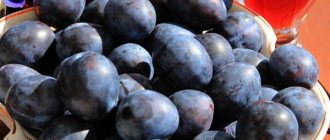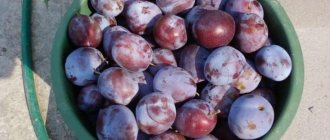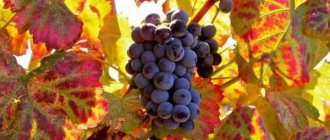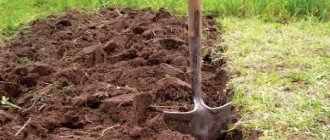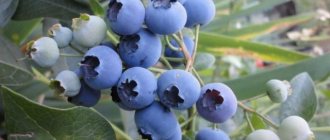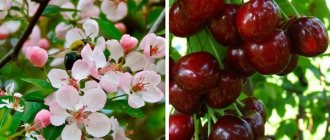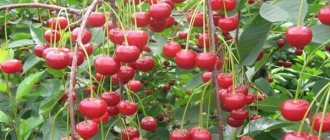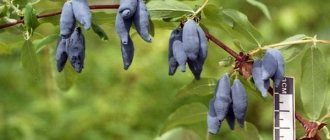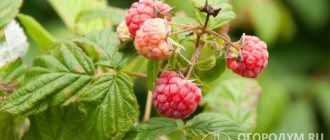Blue Dar plum is a domestic variety that is distinguished by its unpretentiousness and hardiness, with a fairly high yield. It is popular in the southern part of the Russian Federation, although it thrives in various regions, including Siberia.
The small, but sweet and juicy fruits of the Blue Gift plum variety have a characteristic dark blue hue. This article will tell you in more detail about this variety, its yield and external characteristics, the secrets of planting and care, and will provide reviews based on the experience of gardeners.
Description of the plum variety Blue Gift
The variety is planted mainly in the south; the tree is gradually becoming popular among gardeners in the central regions of the country, for which it was recommended. If comfortable conditions are created, the mid-ripening Dar plum can also be grown in Siberia.
The compact tree of the Blue Gift variety is medium-sized, rises up to 3 m. The trunk is 60 cm high or slightly more, with gray rough bark. The crown is elongated, oval in shape, as created by the skeletal branches, and does not thicken much. Young shoots are pubescent, brown with a grayish tint. Rings with bouquet branches are created on them. The buds deviate from the branches. The dark green leaves are lanceolate, finely toothed along the edges, wrinkled above, with a pubescence below.
The white 5-petalled plum flowers of this variety are formed in such a way that self-pollination occurs easily. Small oval fruits with an inconspicuous side seam weigh 14 g. The skin is dark purple with a strong waxy coating. The very dense and juicy pulp of the Blue Gift plum is greenish-yellow, fibrous, with a granular structure. The peduncle is not too long, without pubescence. Dry fetal separation. The mass of the oval seed, which is easily separated from the pulp, is 1 g, or 7.1% of the weight of the fruit.
The refreshing sweet and sour taste of the Blue Gift plum variety is pleasant, appetizing fruits with a light aroma. They include:
- 8.5% sugars;
- 15.44% dry matter;
- 0.99% free acids;
- 7.17 mg of ascorbic acid per 100 g of plums.
Experts gave the Dar variety a score of 4 points.
Comment! The dense skin and pulp allow the fruits to endure transportation painlessly.
Characteristics of the variety
The properties of the new plum are remarkable: it is suitable for industrial cultivation. The variety grows and develops well on loose, fertile soils close to neutral acidity. The site is prepared in advance by enriching the soil with alkali. Plums prefer loams, but not heavy soils, which are diluted with sand.
Drought resistance, frost resistance
The hardy plum emerges from the winter with temperatures typical of the Central region without any significant losses and with moderate damage to the branches. The winter hardiness of the tree is rated at 2.5 points. Flower buds showed below average frost damage results. During flowering, the plum tree also does not suffer much from return frosts.
Blue Gift is a moisture-loving variety, like all plums. Care includes regular watering in case of insufficient rainfall during the periods of bud and ovary formation.
Pollinators of plum Blue gift
The variety blooms in the second decade of May. Ripe plums are harvested from the middle or third ten days of August.
The blue gift is self-pollinating, so it can serve as a good pollinator for early and late varieties of plums. Experienced gardeners advise planting 2-3 trees with different ripening periods on a plot in the climate of the middle zone. Other plums have a beneficial effect on the yield of the Blue Gift plum variety.
An approximate list of recommended varieties:
- Yakhontovaya, Skoroplodnaya, Morning, Opal – early plums;
- Eurasia 21, Amusing, Egg blue – medium;
- Memory Timiryazev, Alexy, Tula black or Hungarian Moscow - late ripening.
Attention! The Blue Gift variety is a recognized late-spring honey plant.
Productivity and fruiting
You can taste the first plums from the 4th year of tree growth. The fruits of the variety are formed on last year's growth and bouquet branches. Plum with stable yield: during the test, out of 16 years, only 4 seasons were unsuccessful.
One mature tree produces up to 35 kg of fruit. Fruiting continues for 21 years.
Area of application of berries
Table plums are eaten fresh and frozen to preserve vitamins. Various jams, jams, compotes, sauces are made from the fruits, and juice is prepared.
Resistance to diseases and pests
Resistance to the main diseases of the species is estimated at 2–3.5 points, and to pests such as aphids and codling moths – 3–4 points.
Early spring treatment with drugs against the spread of diseases and the proliferation of pests is necessary.
Advantages and disadvantages of the variety
The characteristics of the Blue Gift plum variety indicate its positive qualities:
- compact plum is convenient for intensive gardening;
- self-fertile variety;
- annual abundant harvest of fruits;
- attractive consumer indicators;
- the fruits are transportable;
- average resistance to frost, diseases and pests.
The disadvantages of the variety include small fruit.
Diseases and pests
The Blue Gift plum is resistant to diseases and pests, but some of them can occur due to lack of care:
- The plum codling moth is a caterpillar that eats the fruits of a tree and slows down its growth, promotes rapid falling and loss of color; after harvesting, such a crop should be burned, the soil should be dug up, then covered with burlap around the trunk;
- plum aphid: the affected leaves of the tree become discolored and begin to rot before they ripen; the agents “Nitrophen”, “Benzophosphate”, etc. are effective in the fight;
- knotted leaf roller: the foliage of a tree is rolled up and held together in a ball; “Nitrophen” is an effective remedy for combating leaf rollers, but these pests must be caught manually;
- Gum discharge is a disease that looks like the release of translucent droplets of resin; it is dangerous because infection can get into the affected areas; they need to be cleaned with the edge of a knife and disinfected with a 1% solution of copper sulfate;
- plum pockets - a fungal disease, the affected fruits are pitted, and the pulp becomes unnatural in shape and size, losing its taste; You can fight it with a 3% solution of Bordeaux mixture in the spring before the buds open;
- Klyasterosporiosis refers to fungal diseases, looks like through brown spots on the foliage; affects the fruits, making them heterogeneous with depressed spots, which after some time become convex and covered with droplets of resin. They fight it with a 1% solution of Bordeaux mixture, first before buds open, immediately after flowering, 2 weeks after flowering and 2-3 weeks before harvest.
Landing Features
When planning to start a plum orchard, they study the features of growing trees. Planting and caring for the Blue Gift plum is not difficult, but you need to know a few important subtleties.
Recommended timing
In regions with relatively short summers, plums are planted in the spring to create the most favorable conditions for the tree to survive. In areas with mild winters, the seedling feels comfortable even when planted in autumn.
Choosing a suitable location
Groundwater can approach the surface no closer than 1.5 m. Direct sunlight is important for the variety, without shading from buildings and tall trees. In cold climates, it is better to place plums on the south side of buildings, retreating from the wall to 3–4 m, in an area without stagnant water.
Important! In the lowlands for plums, a hill of up to 60 cm is first poured. Then a planting hole is dug at its top.
What crops can and cannot be planted nearby?
- Gardeners claim that plum bears fruit well next to cherry plum and apple trees, and other varieties of plums, but not pears or cherries. In any case, the interval between trees is up to 4–5 m.
- You cannot plant plums in the shade of a tall tree, fruit or ornamental.
- Berry bushes and strawberries are welcome at a specified distance.
Selection and preparation of planting material
When purchasing seedlings, they are carefully studied:
- 1–3 year old trees;
- the bark is smooth, healthy, undamaged;
- the buds are swollen and alive;
- the roots are fibrous, with several shoots, elastic to the touch.
Before planting, bare-rooted seedlings are placed in a liquid clay mixture for 2–10 hours to moisturize and reanimate. Trees in containers are placed in a barrel of water so that the seedling can be easily released without tearing off small roots.
Landing algorithm
- Spacious pits are prepared to provide the plum with the necessary substrate.
- They drive in a peg to which the stem is tied.
- A seedling is placed on a mound formed from prepared soil and the roots are straightened.
- Cover with soil, compacting it.
- The root collar is raised 4–6 cm above the ground.
- They fill in the sides for the watering furrow, but first fill in the tree trunk circle, which is then mulched.
History of selection
In the international pomological taxonomy, three categories of plums are distinguished, having different origins, despite the fact that in their pedigree, of course, a trace of a wild ancestor is visible.
This is a domestic plum, Chinese and Russian. Their wild ancestors appeared thousands of years ago as a result of spontaneous pollination of cherry plums by blackthorn:
- in the Balkans, Central and Asia Minor - the ancestor of the domestic plum;
- in the Far East and Amur region - Ussuri plum;
- in northwestern China - willow plum;
- in the mountainous regions of North America - American plum;
- in the north of the North American continent - Canadian plum.
All of them were subsequently included in the selection process, the main goal of which was to give the fruits high consumer qualities, to spread the plum as a species to the northern regions and adapt it to industrial cultivation.
Cultivated varieties of folk selection from the Adriatic came to Europe and Russia as domestic plum. A new stage in the creation of domestic hybrids of this species began in the process of experiments by I.V. Michurin.
Fruit trees were grafted with Ussuri wildflower and became generally recognized winter-hardy varieties of Russian plum. The Chinese plum went through the process of improvement at the California Breeding Center, in the process of crossing with American varieties.
Plums are crossed not only within the species, with cherry plums, but also with apricots. The result was a new hybrid form, which was given the name “black apricot”.
Aftercare for plums
The medium-growing variety has no problems with pruning. It is important to remove branches that grow from the conductor at a narrow angle, less than 45 degrees. From the beginning of autumn and early spring, broken and damaged shoots are removed.
The plum tree needs watering. For young trees, 10 liters is enough for 2 weeks, and for adults – 20–30 liters to moisturize the roots. After moisture-recharging irrigation in the fall, the ground is mulched with humus and dry grass, and then, before frost, the seedlings are wrapped in a special rodent net. Protect with a thick layer of paper or agrofibre.
Warning! Cracks may appear on the plum bark during periods of wood growth and sudden changes in air temperature. The bark is peeled and treated with varnish.
Every 4 years, in the spring, the bark is cut with a knife to prevent it from cracking. Only the bark is cut into a strip of up to 20 cm. The sections are processed.
The Blue Gift plum is fed with the NPK complex from the 2nd year of growth; magnesium and boron are beneficial for the tree. Humus is often used for mulch.
Diseases and pests, methods of control and prevention
The variety may suffer from moniliosis and klyasterosporiosis, other fungal diseases, which are prevented by autumn garden cleaning, spraying with fungicides in early spring, before and after flowering. Pests: weevils, caterpillars and other insects are destroyed with insecticides. Stripping the bark and removing diseased branches and fallen leaves also stops their spread.
How to care
It must be said that the tree is unpretentious in care: even a novice gardener can grow the Blue Gift, like the Yakhont plum, if, of course, the climate is suitable. The plant reaches a maximum height of only three meters, so there is no need to bother with grafting dwarf plum species and frequent pruning. Let's find out what aspects of caring for the Blue Dar plum must be observed in order to achieve good growth and consistently high yields from the tree.
Home care for amaryllis flowers: planting, propagation
Watering
You can water either from a hose or from buckets. But in the latter case it is easier to control the volume of water. An adult plant needs to use 3-5 liters of water per watering. It is recommended to water the plant in the evening so that the sun's rays do not burn the foliage. It is necessary to pour water at the root, and the water temperature should be above zero. It is also worth learning more about how to care for the Russian cherry plum Zlato Scythians.
At the beginning of the formation of ovaries, it is important to prevent the soil from drying out, as this can lead to the ovaries falling off. Consequently, there will be no fruit.
Top dressing
The tree loves and responds gratefully to proper feeding. In the first year after planting, there is no need to additionally feed the seedling - since the soil in the hole is already fertilized. But in the second year, third and all subsequent years, fertilization becomes necessary.
Blue Dar plum needs nitrogen and potassium-phosphorus compounds. You can use both organic and mineral fertilizers. This variety also needs magnesium fertilizers, but less often than the first three. You can choose a composition such as potassium magnesium, which contains suitable components in reasonable proportions. Nitrogen-containing fertilizers are applied in the spring, and potassium-phosphate fertilizers in summer and autumn. But what kind of feeding should be used for the Gek cherry plum can be found out from the description.
In the video - feeding a plum tree:
Attention: manure should not be used to fertilize the land. If you really want organic matter, then use compost or humus. It is important not to overdo it with fertilizers, since if there is an excess of them, it is possible that the roots of the plant will burn.
Trimming
Caring for this tree is made easier by the fact that the Blue Gift does not grow too much in height, and the density of its foliage is average: you don’t have to bother too much with pruning. It is only important to give the crown the correct oval shape, and in the spring carry out sanitary pruning, removing broken and damaged branches.
It is recommended to trim branches while they are still green. If they become woody, the process of pruning will be much more painful for the plum tree. Wounds after cutting old branches do not heal well and often become a breeding ground for germs and pests.
What is the description of the Eurasia plum, and what are the features of growing this variety, is described in the article at the link.
And here you can see what the Stanley plum looks like in the photo.It will also be interesting to know what fruit trees and shrubs exist for the garden: //gidfermer.com/sadovodstvo/yagody/plodovye-derevya-i-kustarniki-dlya-sadovogo-uchastka.html
It will also be useful to learn about the existing description of the Obilnaya plum variety.
Pests and diseases
The Blue Dar plum is generally resistant to disease and damage from harmful insects. But some preventive measures are still required. So, periodically spray the plant with insecticides to prevent insect attacks. And if the tree gets sick, use Bordeaux mixture to treat it.
Video - pest control:
